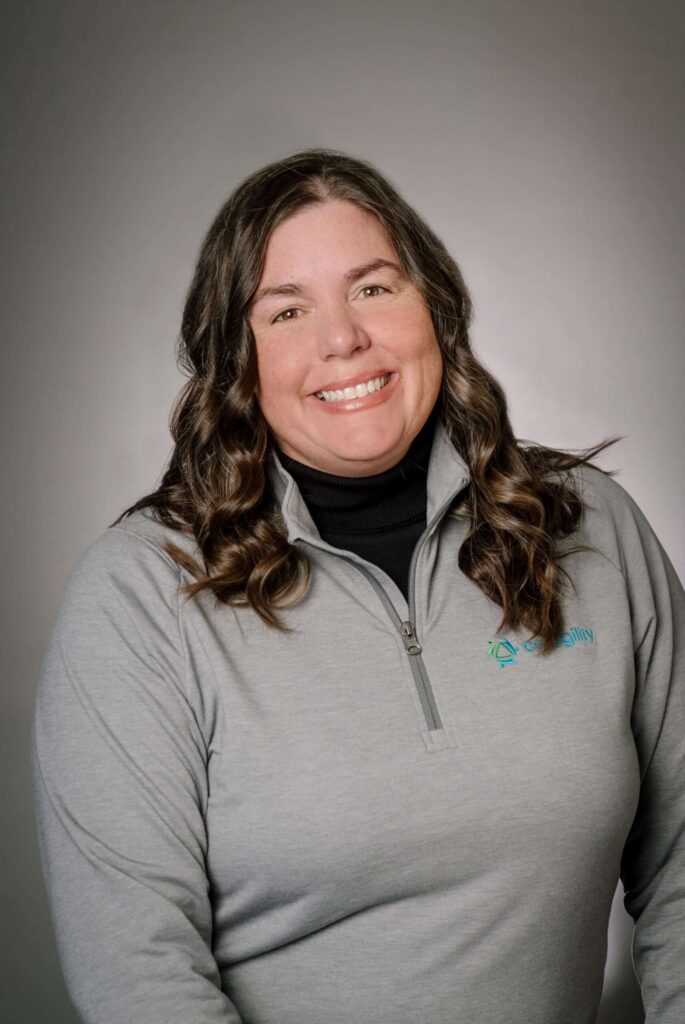Many would agree that the nursing profession isn’t for the faint of heart. RNs see it all. Although Sarah Lake, MS, RN, CCRN, didn’t initially set out to be a nurse, her early years working in the criminal justice system offered plenty of parallels.
Sarah first pursued undergraduate studies in political science and criminal justice, earning her bachelor’s degree at the University of South Dakota (USD). The Sioux Falls native then held positions as a correctional officer and a court services officer, doing what she describes as “the equivalent of felony probation and supervision for community members who don’t go to prison.”

Clinical Program Manager, Caregility
Like the clinical work she’d eventually embark on, Sarah’s Corrections roles operated under a paradigm that put emphasis on prevention through early intervention. The challenge was that she oversaw a population that was profoundly underserved with no access to social services. Sarah recognized that the lack of support services was an impediment to her ability to adequately help those in her community. This point of frustration led her back to school to find a different way she could help.
Sarah earned her nursing degree at USD intending to go into community, public, or mental health. After a preceptorship at the Department of Health setting up points of distribution during H1N1, she landed a critical access nursing role in Chamberlain, SD, at Sanford Chamberlain, ultimately returning to Pierre, her home community, with a role in Avera St. Mary Hospital’s ICU. That role introduced Sarah to a relatively new theory of care. Avera St. Mary’s eICU program allowed patients to receive services from remote clinicians while remaining close to home and family.
“The hospital had an eICU system that allowed clinicians to push a button to get instant access to intensivists and critical care nurses to help take care of critical patients whom we would have otherwise had to transport to tertiary care,” Sarah explains. “When I pushed the button for the first time [to get help] on a drip I was unsure of, I was sold.” Sarah immediately recognized the potential that virtual care posed to broader use cases.
“The thing I am the most passionate about is improving the delivery of patient care.”
– Sarah Lake
“During my career, I did temp work outside of hospitals and worked as a flight nurse, but I always came back to the eICU at Avel eCare (then Avera eCare) because I liked virtual care’s ability to give folks world-class care in their home community. When I came back to work full time in the Sioux Falls area at Avel eCare, one of the service lines was a multi-specialty clinic offering specialties to IHS. Sixty percent of the services we were supporting were mental health or psych related – precisely the kind of services I thought we needed when I was in Corrections.”
When COVID-19 hit, Sarah and her team again turned to telehealth to remotely support patients isolated at home. It wasn’t long before Sarah was recruited by Caregility to put her virtual care experience to work supporting hospitals across the nation looking to follow suit. Today, Sarah helps health systems hone their telehealth strategy, design virtual clinical workflows, and stand up EMR-integrated programs that improve care delivery for patients and providers.
Sarah sees hybrid care fueling what’s possible in healthcare. That includes the ability to support remote family involvement or group visits, patient and staff education, and patient monitoring as an added safety layer and another way to build relationships with patients.
“Post-COVID, patients are sicker and there aren’t as many clinicians available to take care of them,” Sarah notes. “Adopting a virtual nurse is one way teams can meet in the middle. Medicine is also getting much smarter. Wearables and home-based apps have tremendous potential to further personalize care and proactively improve outcomes. Increased use of AI will not only enhance care delivery but also optimize operations. It will account for things people don’t think about when they’re putting patients into beds – like higher fall risk if the patient is placed at the end of the hall – to support the best utilization of space. What locations are best for the recovery of specific conditions? What staff do we have to take care of them? We’ll see the use of AI in those operations.”
For those looking to implement a virtual care program, Sarah offers five points of advice:
- Work with a multidisciplinary team including clinical, administrative, and IT stakeholders to define your goals and objectives based on your unique pain points.
- Conduct a feasibility study to determine what it will take to launch your program. Consider time and resource requirements, seeking outside expertise as needed.
- Define your clinical protocol. Demonstrate ways the solution will benefit patients, lighten staff workload, and foster new professional development skills among staff who will use the tools.
- Select technology that supports your identified workflows. Will telehealth endpoints be cart-based or wall-mounted? What integrations are desired? Be mindful of regulatory compliance and network factors.
- Iterate and re-iterate constantly.
“Virtual care and telehealth bring us to a whole new level of being able to deliver care to absolutely everybody in a quick, cost-effective manner, even in geographically isolated communities with socioeconomic struggles,” says Sarah. “Today we can have a diabetes patient see a world-class endocrinologist at home on an iPhone. Virtual care lessons I’ve learned along the way have only broadened what I see as the future potential.”
Interested in connecting with a Caregility Clinical Program Manager to discuss your hybrid care strategy? Contact us today!







